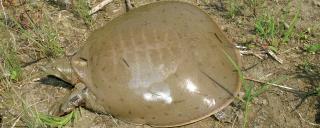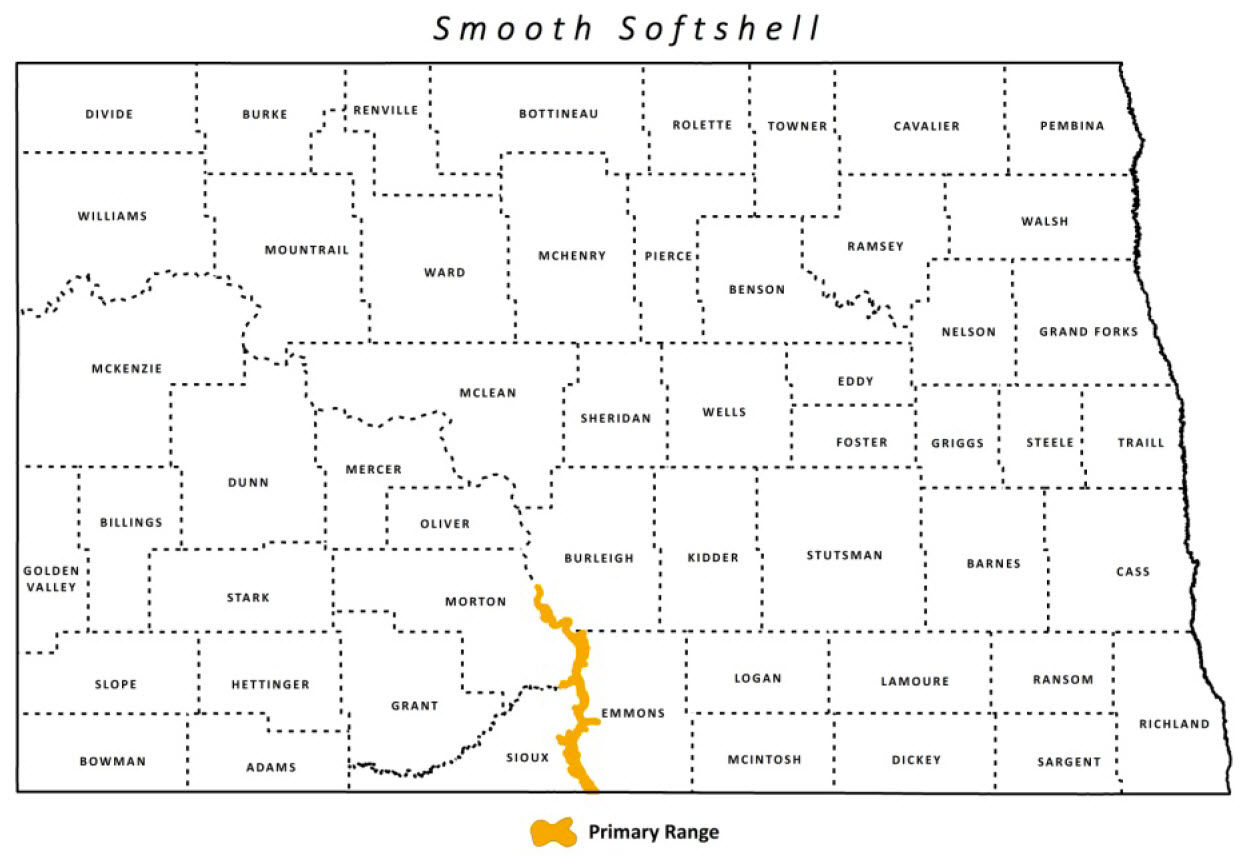
Smooth Softshell
| Scientific Name | Apalone mutica |
|---|---|
| General Description | L 14” for females and 7” for males. The carapace is circular in shape, olive-gray to orangebrown, smooth, flat, and leathery-like. |
| Status | Year-round resident. |
| Abundance | Rare. |
| Primary Habitat | Large rivers and streams with sandy Beaches or sandbars. |
| Federal Status | No federal status. |
| Reason for Designation | Documented at only a few locations in the Missouri River. Habitat alteration has greatly impacted this species. |
Locations and Conditions of Key Habitat
Preferred Habitat
Softshells prefer permanent streams or creeks with a sandy or muddy bottom and sandy beaches. They may burrow into the sand under shallow water for a long period of time. Frequently bask on river banks and logs, but flee quickly if disturbed. Females do not mature until around 9 years of age, when they lay one to three clutches of 4- 33 hard-shelled eggs on sandbars. Feed primarily on crayfish, small invertebrates, frogs, and small fish.
Key Areas and Conditions for Smooth Softshell in North Dakota
The extreme lower portion of the Missouri River System is the only stretch of river where the turtles have been verified. There are unverified reports of softshells in the Missouri River near the Montana border.
Problems Which May Affect this Species
Habitat
Habitat alteration from the impoundment of the Missouri River has affected the distribution of this species. Availability and quality or the alteration/destruction of sandbars in the lower Missouri River stretch could affect nesting.
Other Natural or Manmade Factors
Nesting turtles may be disturbed by human recreation on sandbars.
Research and Survey Efforts
Current Research or Surveys
- North Dakota State University is surveying reptiles and amphibians in SE North Dakota. This includes the Missouri River.
Previous Research or Surveys
- The North Dakota Game and Fish Department sampled turtles in the Missouri River. 2005-2007.
- Wheeler and Wheeler (1966) conducted a statewide survey of all amphibians and reptiles, as well as compiled existing records. The turtles were found statewide in permanent water.
- Hoberg and Gause (1992) recorded personal observations of Snapping Turtles in North Dakota.
- A compilation of all records in North Dakota by Jundt (2000) listed 3 documentations of the False Map Turtle in the state.
Additional Research or Surveys Needed
Future survey efforts could include additional trapping efforts along the Missouri River and in smaller streams leading into the Missouri.
Management Recommendations
- Avoid clearing or replacing natural vegetation along shoreline, providing at least 50-75 feet of undisturbed habitat to protect water quality and prevent erosion.
- Leave logs, snags, and other woody debris on site, or replace if removed.
- Limit erosion control structures such as retaining walls or riprap that will limit or prevent access to the shoreline and adjacent habitat.
- Do not alter natural river undulations, backwater areas, or sand and gravel bars.
- When possible, keep cattle out of streams to reduce impacts on water quality and the streambed.
Monitoring Plans
Currently no monitoring is taking place. Possible monitoring options could include school classes/programs including universities, the general public through the NDGFD incidental reporting system, or national monitoring initiatives such as PARC. Monitoring should be directed at all turtle species.
2005-2015 Progress
The Smooth Softshell turtle maintains its Level III Species of Conservation Priority ranking. Turtle surveys of the Missouri river from 2007 to 2009 provided more confirmed sightings, but little is still known of this species life history details in the state.

Note: A listing of works consulted when compiling the information on this page may be found in the 2015 State Wildlife Action Plan.
